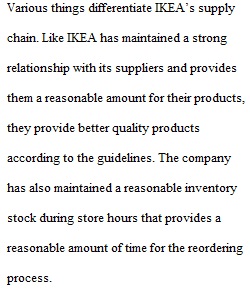


Q IKEA is maybe one of the most loved and hated retail stores in existence. Consumers love the large selection, chic styling and low prices offered on ten thousand furniture and home furnishing items. However, not everyone loves the shopping experience, which includes navigating a maze of displays, deciding from numerous features and options, waiting in lengthy checkout lines and then having to stack heavy boxes into your vehicle. However, the frustration is not over yet, as most items require assembly, which involves fighting the sometimes-confusing assembly instructions without losing or breaking any of the much needed assembly fasteners. Regardless though, IKEA is doing something right as it has grown since 1943 to a top 40 brand name with nearly $40 billion in annual sales serving 936 million customers in over 400 stores and an additional 2.3 billion on-line searches. But what makes IKEA different from any other home-furnishing store? And how has this difference fueled its success? Part of that answer lies in the design of its warehouse, distribution and order fulfillment system. Let’s dig deeper…. Start by reading the following article to learn more about IKEA'S inventory management strategy: https://www.tradegecko.com/blog/ikeas-inventory-management-strategy-ikea (Links to an external site.) First, let’s meet some of the IKEA associates and learn a little more about their work culture in this video entitled “The IKEA Group: A Great Place To Work” Lastly, we will see how IKEA connects Suppliers to Customers through a simple and effective warehousing and distribution design concept by watching this video entitled “IKEA’s Supply Chain” Question 1: What is unique or different about Ikea’s supply chain versus other home furnishing companies? Question 2: How does the flat pack design concept contribute to warehousing, distribution and logistics efficiency? Question 3: Where has IKEA invested in automation and technology and what benefits or returns to do they get on this investment? Rubric Case Study Rubric Case Study Rubric Criteria Ratings Pts This criterion is linked to a Learning OutcomeApplication of Chapter Concepts to Case Study Example 10 to >7.0 pts Excellent Supports CS diagnosis and opinions with strong relevant arguments and well documented evidence; presents a balanced and holistic critical view; interpretation is both reasonable and objective. CS response shows evidence of knowledge and understanding of assigned reading and interactive exercises. Provides quality and quantity of relevant concepts applied to the specifics of the CS. Includes analytics, research, observation, ideas and recommendations, potential solutions and sensitivity analysis. Goes beyond the basic answers to the prompts and demonstrates thoroughness of responses by incorporating numerous chapter concepts. 7 to >5.0 pts Average Supports diagnosis, suggestions and opinions with limited reasoning and evidence; presents a somewhat one-sided or incomplete argument; demonstrates modest engagement of chapter concepts to the ideas presented. Makes appropriate but somewhat vague connections between identified issues/problems and concepts studied in readings, interactive exercises and/or lectures; demonstrates some command of the analytical tools studied; supplements case study with limited research. Answers to the prompts are basic and routine. 5 to >0 pts Poor CS response is light in content with little or no action suggested and/or inappropriate solutions proposed to the issues in the case study. Lacks suitable connection between the issues identified and the concepts studied in the readings and interactive elements; supplements case study, if at all, with incomplete research, documentation and citation of resources. Does not adequately answer all the CS prompts. 10 pts This criterion is linked to a Learning OutcomeContent - Relevance, analytical thought and expression of ideas/points 5 to >3.0 pts Excellent Identifies and demonstrates a sophisticated understanding of the main issues/problems/opportunities in the case study. Presents an insightful and thorough analysis of all identified issues/problems; includes all necessary supporting materials and/or calculations. 3 to >2.0 pts Sufficiently Average Identifies and demonstrates an average understanding of most of the issues/problems/opportunities. Presents a moderate analysis of most of the issues identified within the CS; May lack appropriate elaboration to express ideas/points. May be missing some support materials and/or necessary calculations. 2 to >0 pts Poor Identifies and demonstrates at or below minimum acceptable understanding of the issues/problems/opportunities within the CS. Lacks analytical fortitude, or responses are irrelevant Presents a superficial or incomplete analysis of the identified issues; omits supporting materials and/or necessary calculations. 5 pts This criterion is linked to a Learning OutcomeProfessionalism - Writing mechanics and formatting quality of written submittal 5 to >4.0 pts Impeccable - few to zero errors Demonstrates clarity, content flow and correctness; formatting is appropriate and writing is free of grammar and spelling errors. 4 to >2.0 pts Presentable Occasional grammar or spelling errors, however document offers a clear presentation of ideas; may lack organization or proper formatting. 2 to >0 pts Poorly presented - numerous errors Writing style is unfocused, difficult to follow, rambling, or contains serious/numerous errors; poorly organized or does not follow specified guidelines. 5 pts Total Points: 20 PreviousNext
View Related Questions